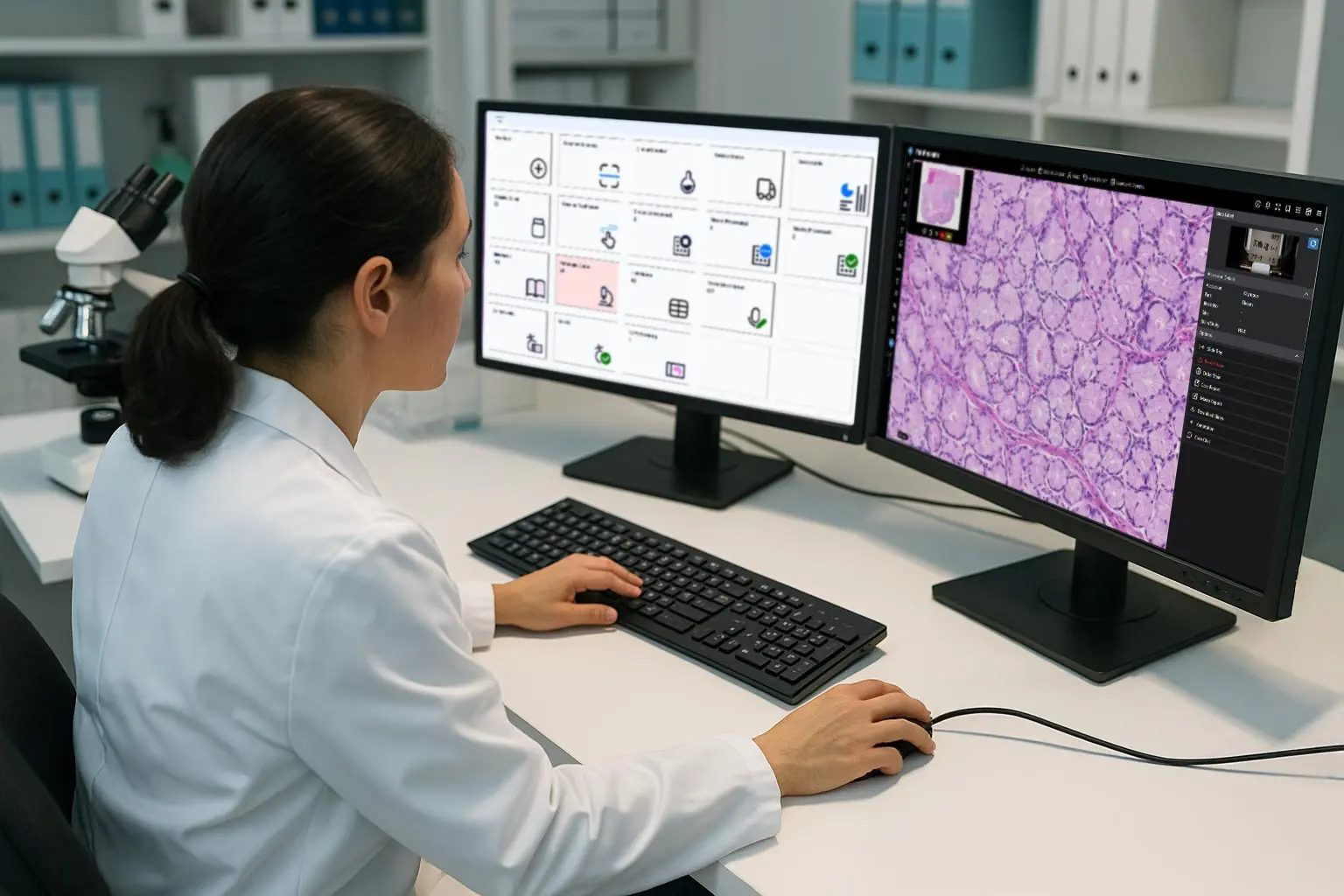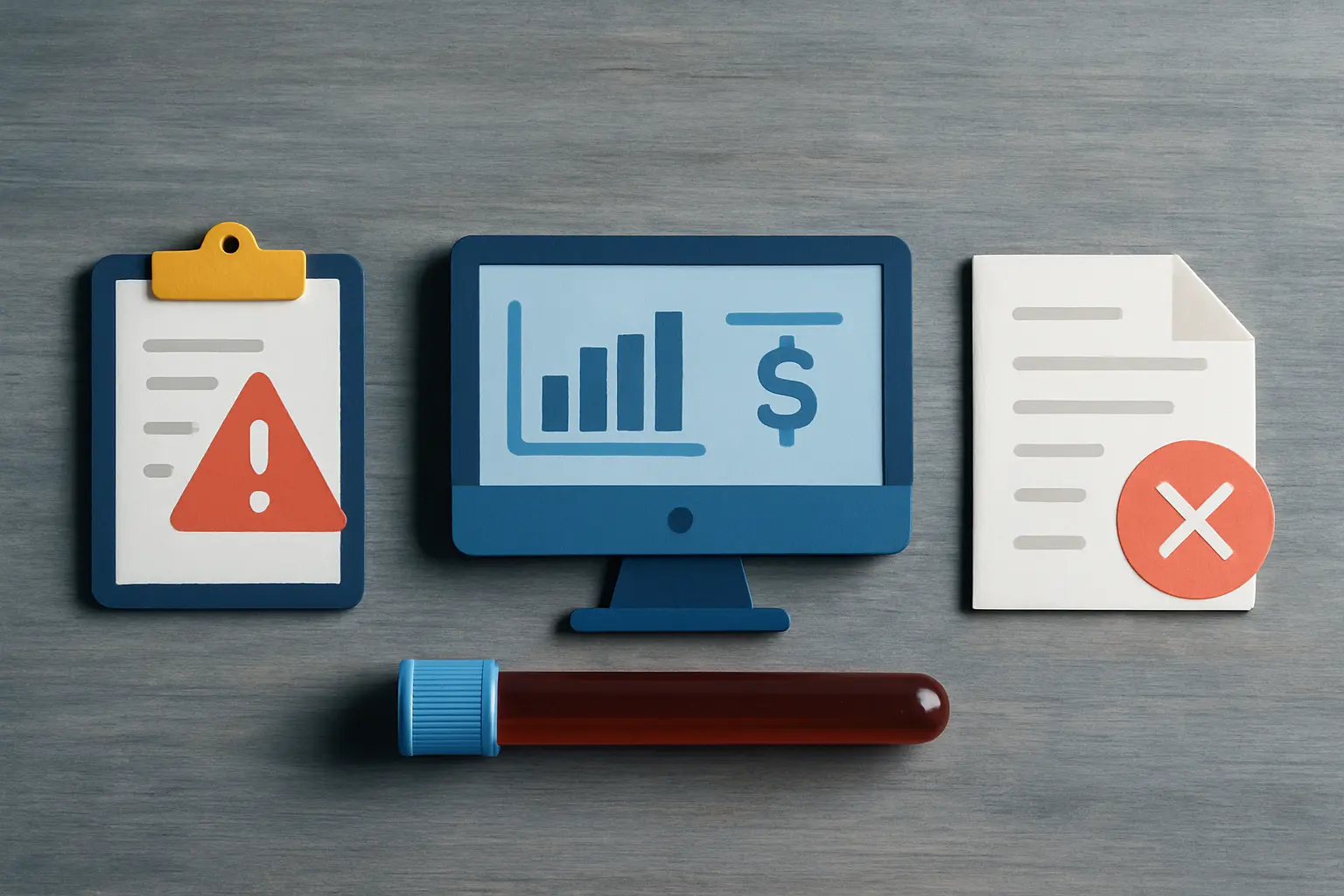Blog
How Specimen Tracking Software Improves Efficiency and Reduces the Chance for Diagnostic Errors
May 20, 2025
The Centers for Disease Control and Prevention (CDC) estimates that approximately 14 billion lab tests are ordered annually. That huge number and the fact that 70 percent of medical decisions rely on laboratory results make it easy to see why accurate sample tracking and an efficient lab sample management system are essential to the diagnostic process.
As the saying goes, “With great power comes even greater responsibility,” so molecular, clinical, and pathology laboratories must implement advanced lab workflow management systems and processes that help ensure accuracy, efficiency, and scalability.
Alarmingly, the CDC estimates that 40,000 to 80,000 deaths each year are linked to preventable diagnostic errors. A recent Johns Hopkins study suggests the situation may be even more severe, pointing to flaws in how the CDC collects data and estimating that medical errors are the third leading cause of death in the U.S., accounting for over 250,000 deaths annually.
Learn More: Top 10 Medical Laboratory Mistakes and How to Prevent Them from Happening in Your Lab
One of the leading - and most preventable - causes of misdiagnosis stems from errors in labeling and tracking tissue samples and specimens. That’s why a reliable, error-free pathology specimen tracking system is vital for labs of all sizes, beginning with precise and consistent sample tracking practices.
Learn More: Reducing Risk in the Modern Laboratory: A Comprehensive Approach

What is Sample Tracking Software?
Sample tracking refers to the lab sample management system by which a patient's sample is labeled and moved through a laboratory information system (medical LIS) and the diagnostic testing process.
Examples of laboratory information systems include the LigoLab Medical LIS & Lab RCM Laboratory Informatics Platform, modern pathology lab reporting software that provides error-free sample tracking with full traceability and a clear view of each step in clinical lab workflow, and enhances overall pathology lab management.
“With our all-in-one medical LIS and lab billing platform with advanced sample tracking, lab directors and managers know who touched the specimen and where it was moved,” said LigoLab CEO Suren Avunjian, who also noted that the diagnostic lab software platform has a lab track system that even accounts for bottlenecks in medical laboratory information system workflow.
“We designed LigoLab to closely mirror real-world lab operations, with full awareness of parent-child relationships as specimens, derivatives, and aliquots move through the lab workflow,” he explained.
The LigoLab platform assigns a specimen-unique identifier as an order is placed, ensuring the security of all specimens across multiple processes and workflows.
The platform tracks the samples through different departments, racks, instruments, and processes, creating a full chain of custody and a comprehensive and searchable audit trail.
All specimens are fully traceable, including batch and send-out orders between facilities. Also, if additional tests are ordered, LigoLab’s sample tracking pathology lab software allows labs to rapidly identify patient information and any previous testing data associated with samples. This advanced capability for sample tracking is further powered by LigoLab’s robust rule and automation engines.
With LigoLab’s enterprise-level LIS software, laboratory workflow management is enhanced, and the need for human intervention and the associated cost is reduced significantly, ensuring efficient sample tracking and streamlined laboratory operations.
Learn More: How Best Practices and Advanced Laboratory Information System Technology Help Ensure Lab Workflow Management
Make Manual Collection and Sample Tracking a Thing of the Past
Sample tracking pathology software systems, like LigoLab’s sample tracking and handling module, reduce errors by ensuring every sample is barcoded and has multiple identifiers. The LigoLab module also automatically creates a log that details where a specimen has been and which technician has handled it.
Even though this level of sample tracking is readily available, many laboratories still create sample tracking logs manually. This is unfortunate because laboratories that rely upon manual, handwritten logs tie up their technicians’ time and face an increased risk of avoidable errors.
No matter how accurate a diagnosis is, it’s useless if it’s not matched to the correct patient. Resulting errors can lead to increased medical costs, delays in treatment, and sometimes the wrong treatment.
An error like this potentially affects two patients, including the person who was misdiagnosed and the person who missed his or her treatment time thanks to the mistake. That’s why preserving the integrity of patient information with reliable sample tracking management is a top priority. It’s a responsibility that should no longer be left in the hands of manual processes prone to major, preventable errors.
It’s true, not all errors are caused by specimen mislabeling. There can be many reasons for a lab error, from mishandling samples to slide contamination. However, incorrect labeling is a significant contributor to patient misdiagnosis.
Patient identification errors in pathology specimens are estimated to occur in about 0.4 percent of cases, with 0.1 percent resulting from mislabeling. While a 0.1 percent error rate may seem minimal, when put up against the 14 billion specimen tests each year, that number becomes more concerning.
“We help labs make sure that every specimen is visible and tracked, and every step and specimen scan is an extra validation point, ensuring that nothing can fall through the cracks,” said Avunjian.
“Because LigoLab’s LIS software platform is built on real-time queues, technicians can quickly identify any specimen that has remained in a queue where it should not be. Additionally, each specimen turnaround time is tracked, and the lab sample management system automatically changes the color of the case to bring attention to the tech of a potential error,” he said.
“It’s easy to try and blame mistakes on overburdened lab technicians or management,” continued Avunjian. “Most laboratories go through extreme lengths to check details. But there can be eight or more separate steps in the testing process, and when you do each step manually, especially in high-throughput labs, human errors are unfortunately inevitable.”
Learn More: The Power of Integration: Unleashing the Potential of LigoLab's LIS System & Lab RCM Platform
.jpeg)
Additional Challenges Associated with Manual Collection and Sample Tracking
One of the major problems associated with improper collection and sample tracking is the sheer volume of testing carried out by medical laboratories. The workload is increasing, and so is the pressure to reduce the time spent on specimens.
Making matters worse is the fact that many labs also need help with an industry-wide workforce shortage. Put bluntly, there was a lack of qualified personnel before the pandemic, and COVID-19 took a growing problem and turned it into today’s crisis.
Learn More: Laboratory Information System Software and Its Role in Overcoming Laboratory Staffing Challenges
When filling out, verifying, and logging a patient’s details, there are multiple points of potential error in a lab’s sample tracking process. For example:
- The interpretation of faded labels or illegible handwriting can result in mistakes.
- Handling slides in batches increases the risk of slides being mismatched to the wrong block.
- The relabeling of slides increases the possibility of error.
- Keying data into a computer can also present risks.
- Pre-printed labels do not contain extra identifiers and can leave loose labels on specimens.
“The LigoLab approach is to generate specimen labels in real-time, as needed and at the right moment,” stated Avunjian. “This drastically improves security and sample tracking. Unfortunately, many labs using legacy laboratory information systems still pre-print labels, and it's a disaster in the making.”
Learn More: Comparing LigoLab Informatics Platform with Legacy Laboratory Information System Software
No matter how careful a laboratory technician is, the risk of human error is always there. When it comes to capturing critical patient information multiple times a day, it is almost assured that mistakes will be made without sample collection and sample tracking support.
Industry Insights: Just-In-Time vs. Batch Processing in the Medical Lab: Examining the Pros and Cons

The Advantages of Using Pathology Specimen Tracking System Software
Uniquely identifying samples early in the process and using barcoding and advanced pathology specimen tracking system functionality with LIS software to identify and track the sample creates efficiencies and reduces errors. That’s why today’s leading laboratories use some form of coding during their sample tracking process.
Most use a numeric code to identify patients and track samples. However, the sample must often be relabeled during the process, which opens the lab to errors. This can be avoided by using barcoding and scanning with sample-tracking LIS lab software embedded in modern informatics platforms.
“When you combine barcoding with LigoLab’s sample collection and sample tracking capabilities, labs can confirm the identity of every sample across their entire clinical lab workflow,” said Avunjian. “If a mix-up occurs, the lab track system within the medical LIS will automatically notify the lab of the error. This error is then recorded so the lab can investigate how the error was made, and hopefully prevent future errors.”
This type of sample tracking ensures that specimens are handled in a way that prevents confusion. Every time a sample is scanned, the laboratory can track who handled it, providing full traceability.
“The great thing about pathology specimen tracking system solutions available in the best laboratory information system software is that it scales as a lab’s volume and sophistication grow,” added Avunjian. “The best LIS software enables labs to track extremely detailed steps within the testing process. This level of detail improves the accuracy of pathology specimen management and reduces errors.”
Learn More: Can Your Laboratory Information System Support the Best LIS System Technology?

Most labs scan barcodes using a hand scanner. However, pathology LIS systems with built-in scanning capabilities are becoming more popular. For example, Radio Frequency Identification (RFID) enabled labels, which LigoLab’s LIS system and laboratory billing platform can recognize without scanning.
“Typically, this pathology software technology would be used at the rack level,” said Avunjian. “Our platform is aware of all specimens within the rack, so as the rack moves throughout the laboratory, the lab information system automatically logs these logistics.”
Although RFID technology is available, it hasn’t yet been widely adopted within the pathology lab. Look for that to change as more laboratory information system vendors follow LigoLab’s lead and develop LIS software that supports this type of sample tracking.
Learn More: What You Need to Know Before Contracting with a Laboratory Information System (LIS) Company
The molecular, clinical, and anatomic pathology laboratory suites rest at the center of the LigoLab Medical LIS & Lab RCM Laboratory Informatics Platform. The suites act as data warehouses for all cases featuring quick order entry, plus label and barcode generation, robust sample tracking, document scanning, grossing touch-screen functionality, electronic histology, swift result entry and sign-out, image acquisition, direct digital interfaces with microscopes and whole slide scanners, reporting, quality control, integration with prior cytology results, auto reflex testing, and more.
The LigoLab platform is designed for use at general or specialized clinical labs and pathology practices, large and small, with easy integrations with existing hospital management systems.
Learn More: The Competitive Edge in Laboratory Outreach: Enhancing Value Beyond Price
Learn More About LigoLab’s Laboratory Information System Software
LigoLab is an award-winning developer of innovative end-to-end laboratory information system software, servicing more than 300 facilities nationwide.
As a comprehensive enterprise-grade LIS software solution, the LigoLab Medical LIS & Lab RCM Laboratory Informatics Platform™ includes modules for anatomic pathology, clinical laboratory, molecular diagnostics, lab revenue cycle management, and direct-to-consumer lab testing, all on one powerful and integrated platform that supports every role, department, and case.
LigoLab is known throughout the lab industry for empowering laboratories to serve patients better, differentiate themselves in the marketplace, scale their operations, and become more compliant and profitable.






